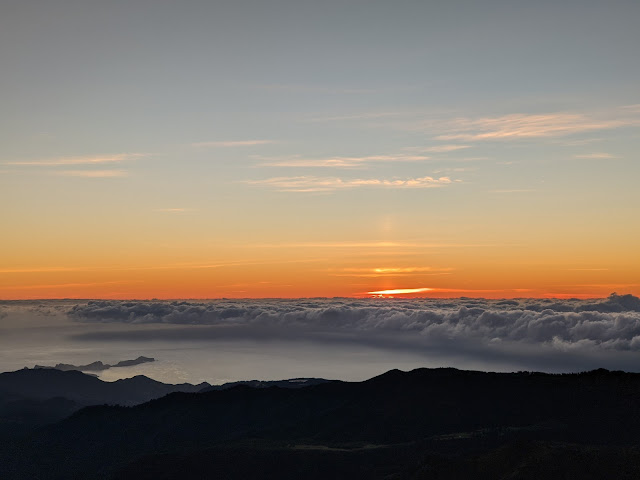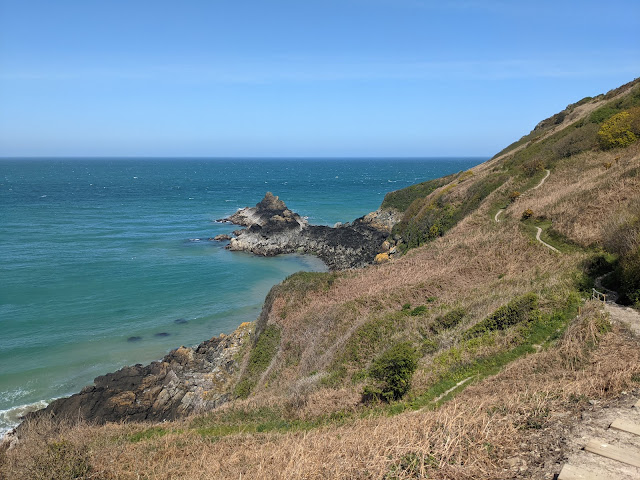Madeira, and on to the Canaries
Greetings from Lanzarote, the easternmost of the major Canary Islands. We arrived about a week ago, after about 10 magnificent days on Madeira.
Madeira is one of the most beautiful places I have ever been, with knife-edged mountains covered by rich, green forests. The interior of the island is veined with levadas, which are channels built to move water from the high, wet parts of the island to the drier lowlands. There are walking trails along side most of these, and they provide access to some eye-popping scenery. We rented a car for 4 days, and we got out early each morning to view the sunrise from some new and exciting spot.
Our first glorious sunrise was from the summit of Pico do Arieiro, Madeira's third highest peak (1,818m). Our poor little car struggled to get to the near-summit parking lot, from which we had an easy stroll to a lovely vantage point.
...and then drove down to the northeast for our first levada walk.
The next morning we started near the eastern tip of the island...
... then drove around to the north side of the island, and wound up looking back at that same knife edge near Pico do Arieiro, but from the west, across a sea of clouds.
Our last morning with the car found us traveling west along the southern coast, then north again for the 25 Fontes (25 fountains) walk. It began with a long descent, followed by a long, gradual climb over the course of 4 hours back to the parking lot, with multiple waterfalls along the way.
We might have stayed longer in Madeira, but the Funchal marina is not the best base from which to explore. It's well-located, but there are bars and clubs all around, which play loud dance music (thump thump thump) until the wee hours (4AM). Not very restful. But we can imagine going back to Madeira, getting a quiet room on the north side, and then hiking our legs off for a few weeks.
From Madeira we sailed to Lanzarote, a 3 night trip. We had originally planned on stopping for a night at Islas Desertas, a small clump of islands southeast of Madeira, but we left Funchal too late in the day to get in before dark, and the anchorage we were targeting is entirely without navigation lights, and full of rocks, so we decided to skip it.
 |
| Leaving Funchal |
We made landfall just before dawn outside of Puerto Calero, a marina on the southeast coast. We anchored for a few hours to get some sleep, then popped in to the marina.
Puerto Calero is a long way from anything else on Lanzarote, and we were (frustratingly) unable to rent a car at all. I rode my bike 20km north into Arrecife to do some shopping, but otherwise we didn't leave the marina. We spent the time doing boat projects; Katy installed bug screens on our windows (we've been increasingly found by mosquitos at night), and we FINALLY ran the necessary cable from our nav desk to the SSB tranceiver in the aft cabin so we can get our long range radio working. Once those were done, we moved on to our current anchorage at the southeastern corner of Lanzarote.
 |
| This schooner arrived just before sunset and anchored off our stern. |
 |
| This morning we went ashore by dinghy to explore. |
Tomorrow we plan to move closer to town (Castillo del Aguila) to shop; we're actually running low on fresh food. After that, we will work our way west across the Canaries. We hope to take dive classes on Tenerife and finally get our scuba certification; it's become increasingly clear that we need to be able to dive to perform some of the routine bits of boat inspection and maintenance. Besides, it's fun!
We're still expecting to cross the Atlantic, starting in December, and landing in the Caribbean in January. We'll keep you posted...






















































